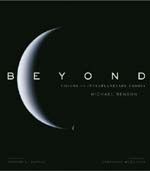
People usually associate squads of bespectacled engineers and scientists as being the sole guardians of space. Beyond: Visions of the Interplanetary Probes by Michael Benson is the type of book that rationalizes and moreover encourages the inclusion of other specialists, especially those in the arts. Containing 295 photographs chosen both for their artistic, awe inspiring impact as well as their voluminous scientific content, the reader will want to quickly put aside numerical calculations about orbital mechanics and let their eyes float across the vistas of other planets. It is easy to imagine that only a thin visor of a helmet separates them from the visions in the book. Michael Benson’s collection of breathtakingly clear images gives credit to the machines that took the pictures and the will of all the bespectacled and clear sighted individuals who worked so hard to get the machines to their complete their mission.
This book is all about its photographs. These come as both true colour and black and white. They range from compact portraits to large expanses. In keeping true to the sources, collages of contiguous single frames give fantastic perspectives including a 110cm x 26cm full colour image of a dust cloud as it storms across a broad swathe of the Martian surface. Each image is silhouetted against a matte black background that enhances the reader’s feeling of ‘being there’. My personal favourites are views of satellites with their host planet behind them and the satellite’s shadow etched on the host’s surface. The details evident in black and white shots of crater rims softened by dunes are better than most tour guides of earthly locales. These photographs are like beauty contest entrants each vying to allure the judge to vote for them.
The photographs are grouped into chapters or collections for each planet, except Pluto, for which no clear images exist. Chapters are introduced with a brief passage discussing the imaging history, the relevant probes and some of the provocative visual features. Often a planet’s chapter includes its satellites though there is a separate chapter for Earth’s moon as well as a chapter for asteroids within the Asteroid Belt. Either adjoining or nearby each photograph is a caption identifying the probe that acquired the image, the date this occurred and a description. As a bonus, there are black and white block drawings of the probes themselves. Leading this beauty contest is a provocative essay where Arthur C. Clarke muses about future explorers. After showing off all the contestants, Benson delivers a short essay on the selection process and the image processing. The book concludes in an afterward by Lawrence Weschler where he contemplates the relative importance of humankind in the context of so much other-world beauty.
I liked the black background and paper type of the book though black, as is its nature, shows up printing artifacts (not many) and fingerprints (becoming more frequent). In addition, sometimes description on the captions do not identify the significance of a picture. Perhaps this may be because there are no features to remark on and only the emotive force caused a picture to be selected.
The clarity of the photographs is so great that I can easily forget myself and try to touch the textures and shapes to gain a tactile sense. It seems I need more than one sense to fully absorb the grandiose scale of the subjects themselves and the specialised effort that made them come into being. I have been perhaps a little bit too guilty of self importance, but after viewing this book my self estimation of where I stand in the scale of things has changed, for the better.
Learn more about the book from Amazon.com
Review by Mark Mortimer
